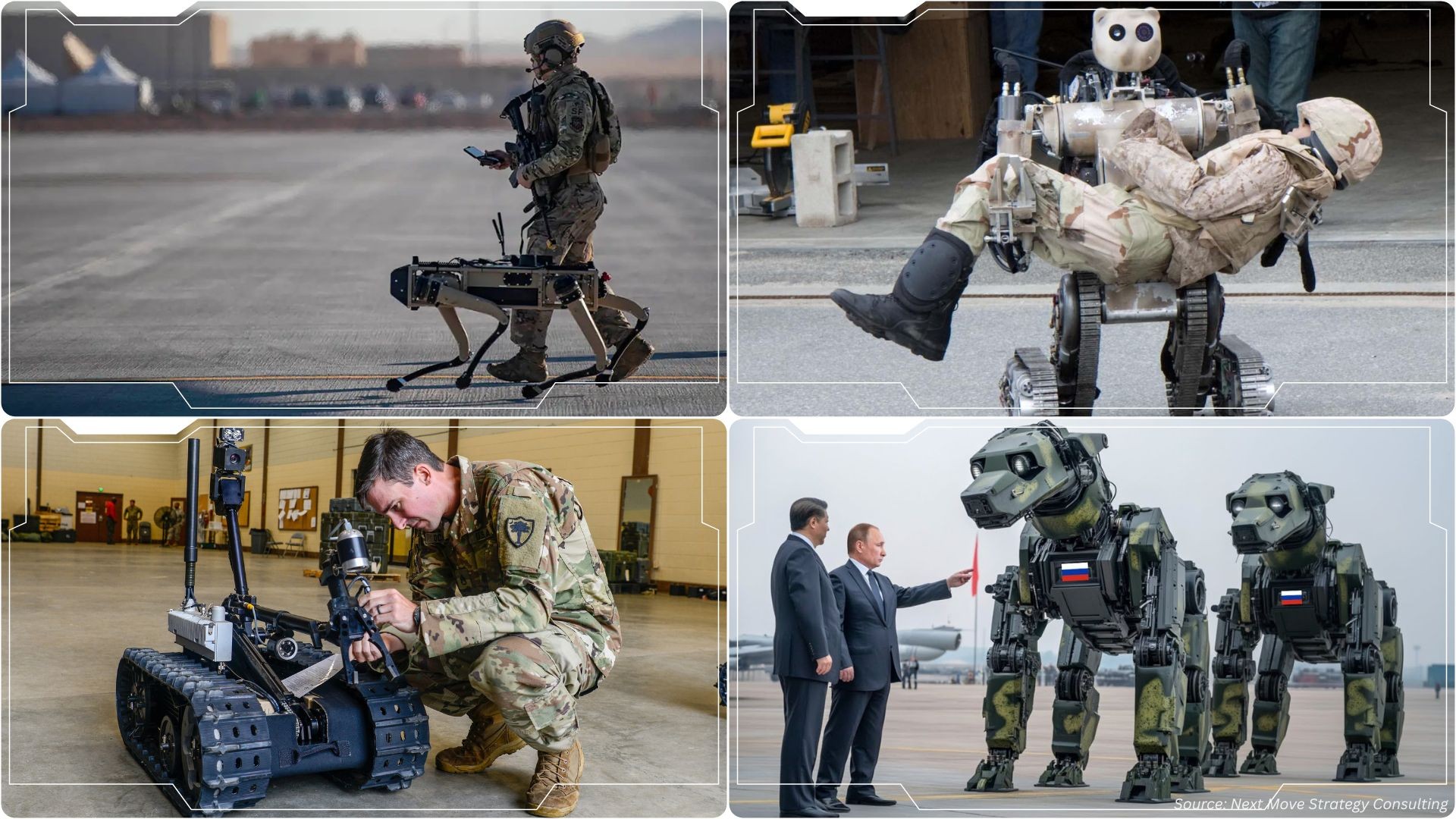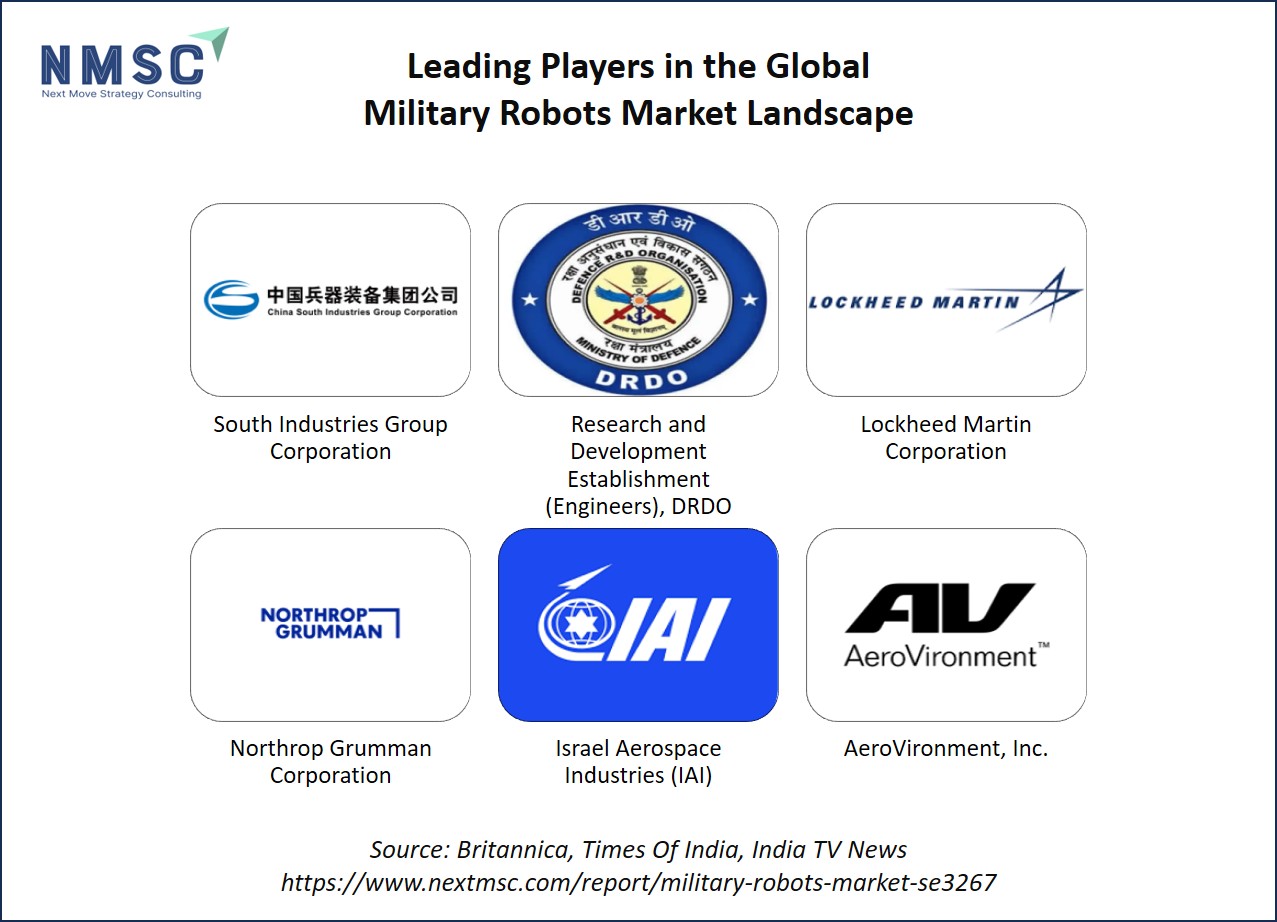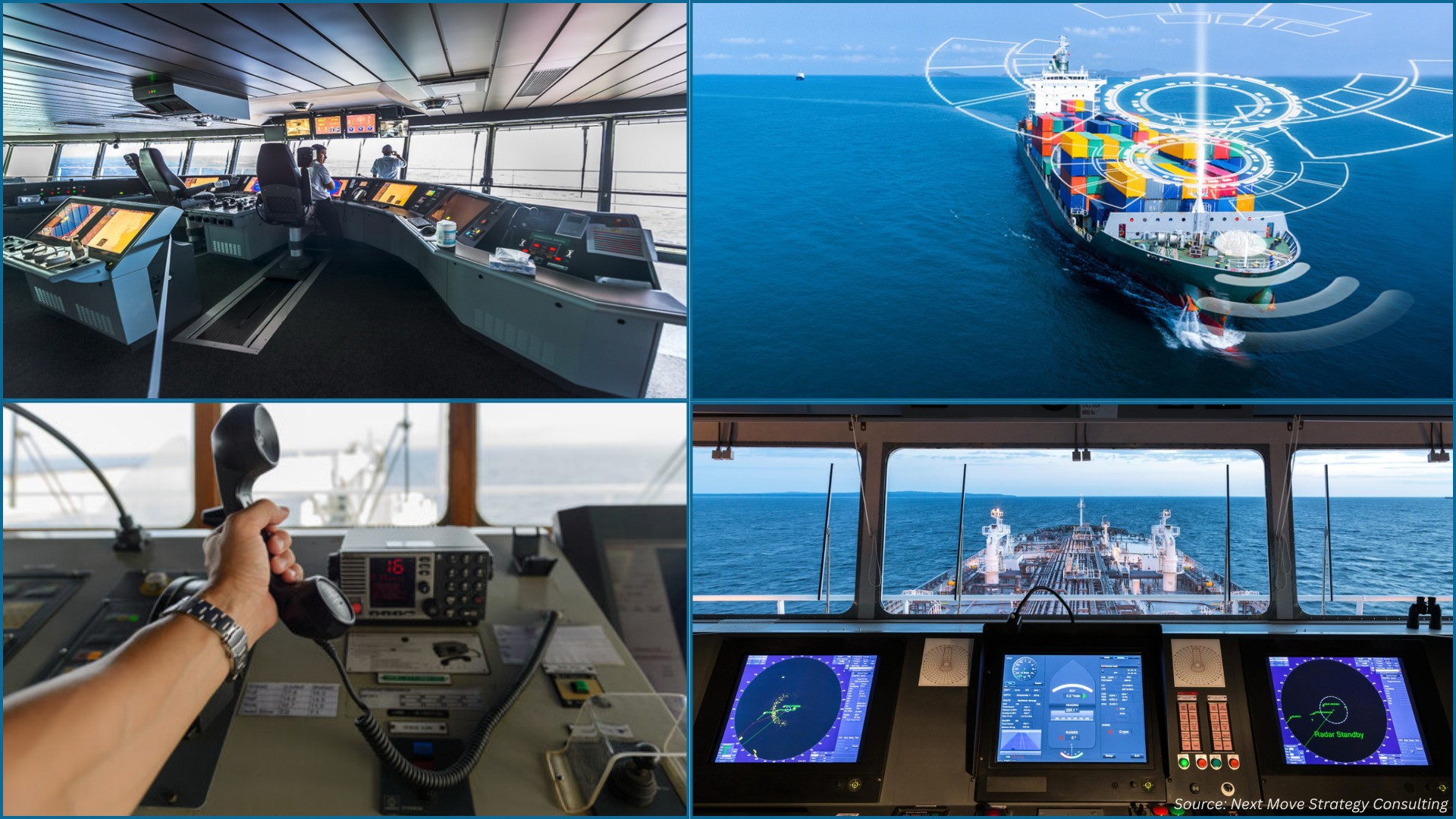Advancements in Military Robots: China and India Lead the Charge
Published: 2025-10-16

The Military Robots Market is witnessing rapid evolution, driven by advancements in artificial intelligence and robotics aimed at enhancing operational efficiency and reducing human risk in warfare. Recent developments in 2024 and 2025 highlight how nations are investing in autonomous systems, potentially reshaping global defense strategies.
Latest Developments in the Military Robots Market (2024–2025)
In 2025, China showcased its "wolf robots" during a People's Liberation Army (PLA) drill, marking their first public appearance in a military exercise. These 70-kg utility quadrupedal robots are designed to neutralize targets, conduct reconnaissance missions, transport equipment, and perform support operations. They demonstrated coordination with drones for combat tasks, including target neutralization and reconnaissance. Chinese military experts anticipate that these robots will alter warfare by enabling great changes on the battlefield, particularly in urban areas, high-altitude plateaus, and mountainous regions.
In a parallel advancement, India's Defence Research and Development Organisation (DRDO) in Pune is developing a humanoid robot for military operations, with prototypes for both lower and upper bodies already tested internally. The project, ongoing for four years, aims for completion by 2027. This robot will operate under human command, handling high-risk tasks such as gripping hazardous objects, opening valves, and navigating unstructured terrain with features like real-time dynamics, fall recovery, and audiovisual perception. It was showcased at a national workshop on advanced legged robotics in Pune.
Concerns about lethal autonomous weapons systems (LAWS), often termed "killer robots," continue to surface in discussions on military robotics. Experts warn that replacing human pilots in drones with computers—technically feasible today—could lead to weapons of mass destruction, terror, and ethical dilemmas, urging international bans similar to those on chemical weapons.
These developments signal a surge in the military robots market, as governments prioritize technologies that enhance combat capabilities while minimizing soldier exposure. Next Move Strategy Consulting observes that such innovations are expanding the market by integrating AI-driven autonomy, potentially increasing demand for customized robotic solutions in defense procurement. This could drive market growth by addressing operational challenges, offering B2B stakeholders like procurement professionals opportunities to evaluate scalable, cost-effective systems that align with strategic defense needs.
Applications Across Industries
Military robots are primarily applied in defense for high-risk operations, but their technologies extend to related sectors.
-
Military and Security: Robots like China's wolf variants conduct reconnaissance, neutralize targets, and transport equipment in complex terrains. India's humanoid is geared for tasks such as handling explosives, pushing obstacles, and operating in hazardous zones, reducing human risk.
-
Other Industries: Legged robotic systems, including bipeds and quadrupeds, have potential in medical services for assistance tasks, home services for daily support, space exploration for navigation in unstructured environments, and manufacturing for handling dangerous materials. However, military applications dominate current developments due to their focus on autonomy and risk mitigation.
Analysis of Dominating and Fastest-Growing Regions
The Asia-Pacific region stands out as both the dominating and fastest-growing area in the military robots market, fueled by substantial investments in defense modernization and technological innovation. This region's leadership is evident through active developments in China and India, which are accelerating adoption rates.
|
Region |
Dominating/Fastest-Growing Status |
Top Countries |
Key Reasons for Leadership |
|
Asia-Pacific |
Dominating and Fastest-Growing |
China, India |
China leads with military drills integrating wolf robots for enhanced combat in diverse terrains, boosting capabilities amid geopolitical tensions. India follows with DRDO's humanoid project targeting operational efficiency by 2027. |
|
North America |
Not highlighted in recent developments |
N/A |
Limited 2024-2025 data; focus shifts to Asia-Pacific innovations. |
|
Europe |
Not highlighted in recent developments |
N/A |
Limited 2024-2025 data; focus shifts to Asia-Pacific innovations. |
China dominates due to its PLA exercises demonstrating robot-drone coordination, which experts say will make deployments more effective than aerial drones alone. India's growth is driven by DRDO's focus on humanoid systems for the Indian Armed Forces, addressing challenges like balancing and information processing in high-risk scenarios.
Key Players with Recent Strategies/Deals
Leading and emerging players in the military robots market are advancing through focused R&D and prototype demonstrations.
-
South Industries Group Corporation (Leading, China): As the developer of the wolf robot, the company emphasizes high mobility and coordinated formations with human operators and vehicles. Their strategy involves creating networks for enhanced combat in complex environments.
-
Research and Development Establishment (Engineers), DRDO (Emerging, India): This DRDO lab is strategizing to complete humanoid robot development by 2027, focusing on actuators, sensors, and control systems for autonomous operations. Recent activities include internal testing and public showcasing at a 2024 workshop.
-
Other Notable Players include:
-
Lockheed Martin Corporation
-
Northrop Grumman Corporation
-
BAE Systems plc
-
General Dynamics Corporation
-
Thales Group
-
Elbit Systems Ltd.
-
Israel Aerospace Industries (IAI)
-
AeroVironment, Inc.
-
Teledyne Technologies Inc.
-
Rheinmetall AG
-
Textron Inc.
-
Hanwha Corporation
-
Milrem Robotics
-
Ghost Robotics
-
Saab AB
-
These strategies link to innovations in quadrupedal and bipedal designs, positioning players to capture market share in defense contracts.
Future Prospects and Examples – NMSC Viewpoint
The future of the military robots industry looks promising, with prospects for widespread adoption by 2027 and beyond. Experts predict these systems will become the "Kalashnikovs of the future"—cheap and producible yet potentially bannable like chemical weapons—while raising moral concerns about machines deciding life-or-death outcomes.
Examples include China's wolf robots altering warfare through battlefield changes and India's humanoid enabling safe handling of mines and explosives. As market analysts, we at Next Move Strategy Consulting project that these advancements will spur demand for ethical AI integrations, offering B2B buyers insights into procurement of systems that balance innovation with international regulations.
About Next Move Strategy Consulting:
Next Move Strategy Consulting is a premier market research and management consulting firm that has been committed to provide strategically analysed well documented latest research reports to its clients. The research industry is flooded with many firms to choose from, what makes NMSC different from the rest is its top-quality research and the obsession of turning data into knowledge by dissecting every bit of it and providing fact-based research recommendation that is supported by information collected from over 500 million websites, paid databases, industry journals and one on one consultations with industry experts across a diverse range of industry sectors.
The high-quality customized research reports with actionable insights and excellent end-to-end customer service help our clients to take critical business decisions that enables them to move beyond time and have competitive edge in the industry. We have been servicing over 1000 customers globally that includes 90% of the Fortune 500 companies over a decade. Our analysts are constantly tracking various high growth markets and identifying hidden opportunities in each sector or the industry. We provide one of the industry’s best quality syndicate as well as custom research reports across 10 different industry verticals. We are committed to deliver high quality research solutions in accordance to your business needs. Our industry standard delivery solutions that ranges from the pre consultation to after-sales services, provide an excellent client experience and ensure right strategic decision making for businesses.
For more information, please contact:
Next Move Strategy Consulting
5th Floor 867
Boylston St, STE 500,
Boston, MA 02116, U.S.
E-Mail: [email protected]
Direct: +18577585017
Website: www.nextmsc.com
About the Author
 Sneha Chakraborty is a passionate SEO Executive and Content Writer with over 4 years of experience in digital marketing and content strategy. She excels in creating optimized, engaging content that enhances online visibility and audience engagement. Skilled in keyword research, analytics, and SEO tools, Sneha blends creativity with data-driven insights to deliver impactful results. Beyond her professional work, she enjoys reading, sketching, and nature photography, drawing inspiration from creativity and storytelling.
Sneha Chakraborty is a passionate SEO Executive and Content Writer with over 4 years of experience in digital marketing and content strategy. She excels in creating optimized, engaging content that enhances online visibility and audience engagement. Skilled in keyword research, analytics, and SEO tools, Sneha blends creativity with data-driven insights to deliver impactful results. Beyond her professional work, she enjoys reading, sketching, and nature photography, drawing inspiration from creativity and storytelling.
About the Reviewer
 Sanyukta Deb is an accomplished Content Writer and Digital Marketing Strategist with extensive expertise in content strategy, SEO, and audience engagement. She specializes in building strong brand visibility through data-driven campaigns and impactful, value-added researched content. With a passion for creativity and innovation, she blends strategic thinking with design and communication to craft meaningful digital experiences. Over the years, she has contributed cross-functional marketing projects, driving measurable impact and audience engagement.
Sanyukta Deb is an accomplished Content Writer and Digital Marketing Strategist with extensive expertise in content strategy, SEO, and audience engagement. She specializes in building strong brand visibility through data-driven campaigns and impactful, value-added researched content. With a passion for creativity and innovation, she blends strategic thinking with design and communication to craft meaningful digital experiences. Over the years, she has contributed cross-functional marketing projects, driving measurable impact and audience engagement.

















Add Comment